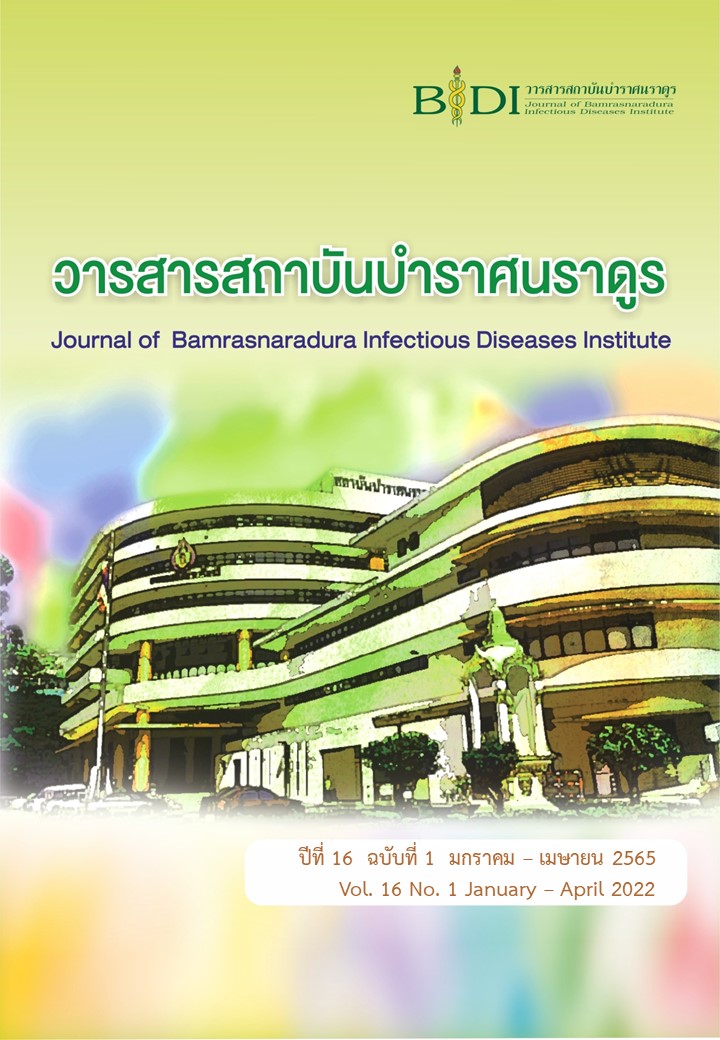การศึกษาการตรวจเท้าด้วยตนเองของผู้ป่วยเบาหวาน จังหวัดแม่ฮ่องสอน A study on the self-foot examination practice among diabetes patients, Mae Hong Son Province
Main Article Content
บทคัดย่อ
เบาหวานที่เท้าเป็นปัจจัยนำสำคัญที่ก่อให้เกิดภาระต่อตัวผู้ป่วยเบาหวานเองรวมถึงระบบบริการสุขภาพ ดังนั้น การตรวจเท้าจึงมีความจำเป็นที่มีส่วนช่วยป้องกันปัญหาจากโรคเบาหวานที่อาจเกิดขึ้นได้กับเท้า วัตถุประสงค์ของการศึกษานี้ เพื่อศึกษาการดำเนินการ การใช้งาน การใช้ประโยชน์ และความพึงพอใจต่ออุปกรณ์สำรวจเท้าด้วยตนเองของผู้ป่วยเบาหวาน อาสาสมัคร คือ ผู้ป่วยเบาหวานจากการสุ่มตัวอย่างตามเกณฑ์ จำนวน 34 ราย ของโรงพยาบาลส่งเสริมสุขภาพตำบลหมอกจำแป่ อำเภอเมือง จังหวัดแม่ฮ่องสอน ดำเนินการรวบรวมข้อมูลการตรวจเท้าด้วยตนเองของผู้ป่วย ภายหลังจากการใช้อุปกรณ์สำรวจเท้าด้วยตนเอง ผู้ป่วยจะได้รับการประเมินถึงการใช้งาน การใช้ประโยชน์ และความพึงพอใจต่ออุปกรณ์ดังกล่าว
ดำเนินการวิเคราะห์ข้อมูลโดยใช้สถิติเชิงพรรณนา การวิเคราะห์เชิงประเด็น และ Wilcoxon Sign- Rank Test ผลการศึกษา พบว่า ผู้ป่วยส่วนใหญ่เป็นเพศหญิง ร้อยละ 79.40 อายุเฉลี่ย 57.53 ปี ส่วนเบี่ยงเบนมาตรฐาน 8.71 ผู้ป่วย ร้อยละ 61.76 ดำเนินการตรวจเท้าด้วยตนเอง ในจำนวนดังกล่าว ร้อยละ 55.89 ไม่ใช้อุปกรณ์อื่นช่วยในการตรวจเท้า และมีบางรายใช้กระจกเล็กๆ เป็นอุปกรณ์ อย่างไรก็ตาม ผู้ป่วยร้อยละ 38.24 ไม่ได้ดำเนินการตรวจเท้าด้วยตนเอง เมื่อผู้ป่วยได้ตรวจเท้าด้วยตนเองโดยใช้อุปกรณ์สำรวจเท้าด้วยตนเอง พบว่า อุปกรณ์มีคุณภาพในระดับดีด้านการใช้ประโยชน์สำหรับการตรวจเท้าด้วยตนเอง ค่ามัธยฐานของการใช้งานทางคลินิกภายหลังการใช้อุปกรณ์มีค่าความสะดวกและประสิทธิผลเพิ่มขึ้นอย่างมีนัยสำคัญ ดังนั้น การตรวจเท้าโดยใช้อุปกรณ์สำรวจเท้าด้วยตนเองจึงช่วยเพิ่มความสนใจต่อการดูแลสุขภาพเท้า อย่างไรก็ตาม ควรได้รับการประเมินเพิ่มเติมในประเด็นผลลัพธ์ในระยะยาว และความคิดเห็นของผู้ให้บริการสุขภาพต่ออุปกรณ์ดังกล่าว
Article Details
เอกสารอ้างอิง
Word health Organization. Diabetes, 2020 [internet]. 2020 [cited 2020 June 28]. Available from: https://www.who.int/news-room/fact-sheets/detail/diabetes
Spasić A, Radovanović R V, Đorđević A C, Stefanović N, Cvetković T. Quality of Life in Type 2 Diabetic Patients. Acta Medica Medianae 2014; 31(3): 193-200.
Al-Rubeaan K, Derwish M A, Ouizi S, Youssef A M, Subhani S N, Ibrahim H M, et al. Diabetic foot complications and their risk factors from a large retrospective cohort study. PLoS One 2015 May; 10(5): e0124446. doi: 10.1371/journal.pone.0124446
Mirattanaphrai S, Cooney N, Preechachaiyavit N, Udomchairat R, Khonlaeaid S, Potisat S. Diabetic Foot Care Service for Diabetic Patients – A National Survey Study of Community and General Hospitals in Thailand. JHSCI 2014; 23: 659-666.
Office of the National Economic and Social Development Council. Thailand poverty report, 2017 [internet]. 2020 [cited 2020 August 2]. Available from: https://www.nesdc.go.th/ewt_w3c/ewt_dl_link.php?nid=7787. (in Thai)
Nather A, Cao S, Chen J L W, Low A Y. Prevention of diabetic foot complications. Singapore Med J 2018; 59(6): 291-294.
Lavery L A, Wunderlich R P, Tredwell J L. Disease management for the diabetic
foot: effectiveness of a diabetic foot prevention program to reduce amputations
and hospitalizations. Diabetes Res Clin Pract 2005; 70: 31-37.
Maykut P, R Morehouse. Beginning Qualitative Research: A Philosophic and Practical Guide. London: The Falmer Press; 1994.
Wayne, W., D. Biostatistics: A foundation of analysis in the health sciences 6th ed. New York: John Wiley & Sons, Inc; 1995.
IBM Corp. Released 2011. IBM SPSS Statistics for Windows, Version 20.0. Armonk, NY: IBM Corp.
Hsieh Y-L, Lee F-H, Chen C-L, Chang M F, Han P-H. Factors influencing intention to receive examination of diabetes complications. Asian Nurs Res 2016; 10(4): 289-294.
Branch J, Lindholm L. Effect of Interactive Education on Diabetic Self-Foot Examinations in Type 2 Diabetes. J. Nurse Pract 2020; 16(1): e13-e15. doi: https://doi.org/10.1016/j.nurpra.2019.09.007
Miller S E, Lee J J. A Self-Care Framework for Social Workers: Building a Strong. FAM SOC 2013; 94(2): 96–103.
Dewi F, Hinchliffe R J. Foot complications in patients with diabetes. Surg Oxf 2013; 31: 240-245.
Schaper N C, Van Netten J J, Apelqvist J, Lipsky B A, Bakker K. Prevention and management of foot problems in diabetes: a Summary Guidance for Daily Practice 2015, based on the IWGDF Guidance Documents. Diabetes Metab Res Rev 2016; 32(s1), 7-15.
Kalish J, Hamdan A. Management of diabetic foot problems. JVS 2010; 51(2): 476-486.
Michael A, Del C, Junho A, Lewis R B, Lalli T A J, Wukich D K. The Evaluation and Treatment of Diabetic Foot Ulcers and Diabetic Foot Infections. Foot & Ankle Orthopaedics 2018: 3(3): 1-11.
Chin Y-F, Liang J, Wang W-S, Hsu B R-S, Huang T-T. The role of foot self-care behavior on developing foot ulcers in diabetic patients with peripheral neuropathy: a prospective study. Int J Nurs Stud 2014; 51(12):1568-1574.
Margolis D J, Malay D S, Hoffstad O J, Leonard C E, McCurdy T, Tan Y, et al. Economic burden of diabetic foot ulcers and amputations, Data Points #3 [internet]. 2020 [cited 2020 April 17]. Available from: https://www.ncbi.nlm.nih.gov/books/NBK65152/.
Chin Y F, Huang T T, Hsu B R. Impact of action cues, self-efficacy and perceived barriers on daily foot exam practice in type 2 mellitus patients with peripheral neuropathy. J Clin Nurs 2013; 22: 61-68.


